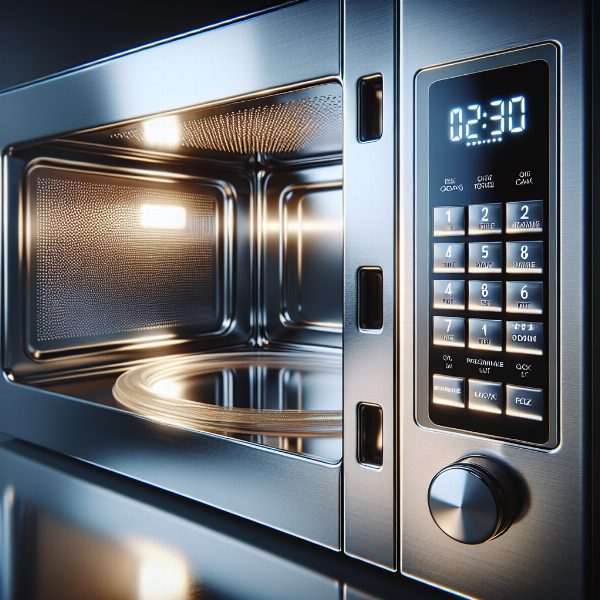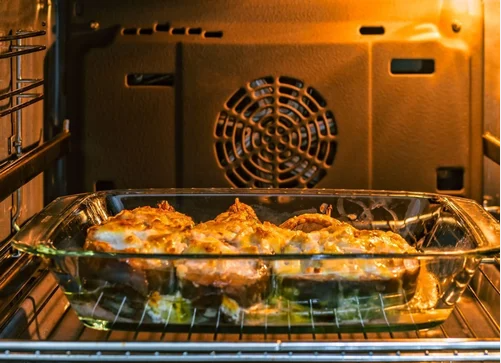Finding the right workhorse for your professional kitchen can feel like a quest. When the lunch rush hits, you need equipment that’s fast, reliable, and tough as nails. That’s where a solid Commercial Microwave Oven Review becomes your most valuable tool. Unlike their domestic cousins, commercial microwaves are engineered for relentless use, consistent results, and the speed demanded by a high-volume environment. Forget reheating leftovers; we’re talking about powering a culinary operation. In this guide, we’ll slice through the marketing jargon and dive deep into what truly matters, helping you find the perfect model to keep your kitchen humming and your customers happy.
What Makes a Microwave ‘Commercial’ Anyway?
Before we jump into reviews, let’s clear up a common question: what’s the real difference between a commercial microwave and the one in your home kitchen? It’s more than just a stainless steel finish.
- Heavy-Duty Construction: Commercial units are built with robust components, from stronger hinges and latches to durable stainless steel interiors and exteriors that can withstand constant cleaning and the occasional bump from a hurried chef.
- Superior Power & Speed: They boast higher wattage (typically 1000 to 2200 watts or more) and often feature multiple magnetrons (the part that generates microwaves) for faster, more even cooking. This means less time waiting and more time serving.
- Built for Repetition: These machines are designed for hundreds of uses per day. They have advanced cooling systems to prevent overheating during continuous operation.
- Simplified, Programmable Controls: Many models have simple, intuitive controls—often with programmable buttons for popular menu items. An employee can press a single button for “Soup” or “Sandwich” to get the exact same result every single time, ensuring consistency.
- Safety and Sanitation Certified: Look for an NSF (National Sanitation Foundation) certification. This means the unit is easy to clean and meets strict public health and safety standards, a must-have for any food service business.
Expert Insight from Chef Antoine Dubois:
“In a professional kitchen, time is everything. A commercial microwave isn’t a luxury; it’s a necessity for workflow. The ability to perfectly steam vegetables or melt cheese in 30 seconds, consistently, service after service, is what separates a smooth operation from a chaotic one. Don’t underestimate its impact on food quality and ticket times.”
The Key Factors in Our Commercial Microwave Oven Review
When we test and evaluate models for our commercial microwave oven review, we focus on the core performance metrics that matter most in a busy setting. Here’s what you should be looking for:
Power and Wattage: The Engine of Your Kitchen
Wattage directly translates to cooking speed. The higher the wattage, the faster your food will heat.
- Light-Duty (Around 1000W): Best for low-volume applications like office break rooms, coffee shops, or dessert stations where it’s used less than 50 times a day.
- Medium-Duty (1200-1700W): The sweet spot for most small- to medium-sized restaurants, cafes, and delis. They can handle frequent use and offer a great balance of speed and cost.
- Heavy-Duty (1800W+): The undisputed champions for high-volume kitchens, hospitals, and large-scale catering. These beasts can handle back-to-back use without breaking a sweat and heat food in a flash.
Capacity and Size: Does It Fit Your Needs?
Think about what you’ll be heating most often. A small 0.8 cubic foot model might be fine for mugs and small plates, but if you’re defrosting large containers or heating full dinner plates, you’ll need a model with 1.0 to 1.6 cubic feet of space. Also, measure your counter space! Some heavy-duty models can be quite large.
Durability and Construction: Built to Last
Look for a full stainless steel interior and exterior. It’s not just for looks; it’s easier to clean and far more durable than plastic. Check the door construction. Does it have a grab-and-go handle or a push-button release? A sturdy handle is generally preferred for high-traffic environments as it’s less prone to failure.

A detailed close-up shot of a modern commercial microwave oven’s interior and control panel, highlighting its stainless steel construction and programmable buttons.
Programmability and Ease of Use: Smart Cooking
The best commercial microwaves remove the guesswork. Models with programmable memory pads allow you to save specific time and power settings for your most popular dishes. This is a game-changer for businesses with multiple staff members, as it guarantees that a customer’s favorite dish is heated to perfection every single time, regardless of who is operating the microwave. Look for simple, easy-to-read controls that can be wiped down quickly.
Our Top Picks: The Best Commercial Microwaves of 2024
After extensive testing and analysis, here are a few models that consistently rise to the top.
| Model Category | Power (Watts) | Best For | Key Feature |
|---|---|---|---|
| Light-Duty Hero | 1000W | Break Rooms, Concession Stands | Compact & Cost-Effective |
| Mid-Range Master | 1200W | Fast-Casual Restaurants, Delis | Programmable & Stackable |
| Heavy-Duty Beast | 2100W | Busy Restaurants, Institutional Kitchens | Dual Magnetrons & Durability |
Spotlight Review: The Amana HDC212 (Heavy-Duty)
This microwave is a true powerhouse. With 2100 watts of power and a dual magnetron system, it heats food incredibly fast and evenly. Its 0.6 cubic foot capacity is stackable, saving precious counter space. We loved the 11 power levels and 100 programmable menu options, making it versatile enough for any kitchen. The stainless steel construction feels indestructible. It’s an investment, but for a high-volume business, its speed and reliability will pay for itself.
Spotlight Review: The Panasonic NE-12523 (Medium-Duty)
Panasonic is a legend in the commercial microwave space, and this model shows why. At 1200 watts, it’s the perfect all-rounder. It features a grab-and-go handle, a compact footprint, and simple dial controls that are incredibly intuitive. While it lacks extensive programming, its sheer reliability and ease of use make it a favorite for fast-paced environments where staff need to get up to speed quickly.

A stainless steel heavy-duty commercial microwave oven shown in a busy, professional restaurant kitchen setting, ready for immediate use.
Expert Insight from Maria Rodriguez, Cafe Owner:
“When I opened my cafe, I tried to save money with a high-end residential microwave. It broke within six months. Upgrading to a real medium-duty commercial model was the best decision I made. It’s faster, my staff can use it without training, and it has never failed me, even on our busiest Saturday mornings. The return on investment is a no-brainer.”
Light, Medium, or Heavy-Duty: Which One Do You Need?
Still not sure? Let’s break it down with a simple checklist.
- Choose Light-Duty if:
- You use a microwave less than 50 times per day.
- Primary use is reheating beverages, small pastries, or single servings.
- You’re a small office, a hotel lobby coffee station, or a convenience store with low food traffic.
- Choose Medium-Duty if:
- You use a microwave up to 150 times per day.
- You’re a fast-casual eatery, a family restaurant, or a busy deli.
- You need a balance of speed, durability, and value.
- Choose Heavy-Duty if:
- You use a microwave more than 200 times per day, often back-to-back.
- You run a full-service restaurant kitchen, a hospital cafeteria, or a school.
- Maximum speed, power, and unwavering reliability are your top priorities.
Conclusion: Investing in the Right Kitchen Partner
Choosing your next unit goes beyond a simple commercial microwave oven review; it’s about investing in your kitchen’s efficiency and your business’s success. The right model will save you time, ensure product consistency, and withstand the pressures of a demanding commercial environment for years to come. Assess your daily usage, consider your menu, and choose the power and durability that match your needs. By making an informed decision now, you’re setting your kitchen up for smoother, faster, and more profitable service down the line.
Frequently Asked Questions (FAQ)
1. How do I clean a commercial Microwave Oven?
Always unplug the unit first. For the interior, use a mild detergent or a solution of baking soda and water with a soft cloth or sponge. Avoid abrasive cleaners or scouring pads. The stainless steel exterior can be cleaned with a damp cloth and a cleaner specifically designed for stainless steel.
2. What does NSF certified mean and is it important?
NSF (National Sanitation Foundation) certification means the microwave has been tested and approved to meet strict standards for public health and safety. It ensures the materials are safe for contact with food and the unit is designed to be easily cleaned and sanitized. For any food service establishment, it is highly recommended and often required by health inspectors.
3. Can I use a residential microwave in a commercial kitchen?
You can, but you absolutely shouldn’t. Home microwaves are not built for the high-volume, repetitive use of a commercial setting. They will break down quickly, heat food slowly and unevenly, and their use will likely void the warranty. More importantly, they typically lack NSF certification, which can be a health code violation.
4. What is a magnetron and why do some models have more than one?
A magnetron is the component inside the microwave that generates the microwave energy to heat food. Standard residential and light-duty commercial models have one. Heavy-duty models often have two (one on top, one on bottom) to distribute energy more evenly and cook food much faster, eliminating the need for a turntable.
5. How much should I expect to spend on a good commercial microwave?
Prices can vary widely based on power and features. Light-duty models can start around $300-$500. Medium-duty units, the most common choice, typically range from $500 to $1,500. Heavy-duty, high-wattage models for intense use can cost anywhere from $1,500 to over $3,000.